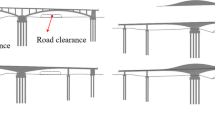Abstract
The erection phase is the most vulnerable period in the life of a structure. However, no mature and effective method for optimizing the construction procedures of large-span steel structures is yet available. Thus, proposing an optimization method for constructing such structures is critical. A real-coded genetic algorithm (GA) was proposed in the present work, and the selection, crossover, and mutation operators were programmed. The proposed algorithm is effective in optimizing integer combinations and sequences, such as an unloading sequence. A series of problems that occurred during the erection of conchshaped complex large steel structures was optimized using the proposed method. Optimum analysis was conducted using MATLAB and the general finite element software ANSYS. The optimal layouts of the lifting points, false work, and unloading sequence were derived. The influence of the GA parameters on its convergence efficiency was also studied. Therefore, the proposed GA method is reliable and effective for optimizing the construction procedures of large-span steel structures.
Similar content being viewed by others
References
Augenti, N. and Parisi, F. (2013). “Buckling analysis of a long-span roof structure collapsed during construction.” Journal of Performance of Constructed Facilities, 27(1), pp. 77–88.
Cheng, J. (2010). “Optimum design of steel truss arch bridges using a hybrid genetic algorithm.” Journal of Constructional Steel Research, 66(8–9), pp. 1011–1017.
Deb, K. (2001). Multi-Objective optimization using evolutionary algorithms. John Wiley and Sons.
Deep, K., Singh, K. P., Kansal, M. L., and Mohan, C. (2009). “A real coded genetic algorithm for solving integer and mixed integer optimization problems.” Applied Mathematics and Computation, 212(2), pp. 505–518.
Fu B., Liu, G. H., and Wang, Z. Y. (2005). “An optimal scheme for hoisting large-scale slender reinforced concrete columns.” Engineering Mechanics, 21(1), pp. 195–199.
Goldberg D. E. and Samtani M. P. (1986). “Engineering optimization via genetic algorithm.” Proceeding of 9th Conference Electronic Computation, ASCE, New York, pp. 471–482.
Gregorio, S. O. and Antonio, T. E. (2013). “Design of planar semi-rigid steel frames using genetic algorithms and Component Method”.
Guo, Y. L. and Liu, X. W. (2008). “State nonlinear finite element method for construction mechanics analysis of steel structures.” Engineering Mechanics, 25(10), pp. 19–24.
Issa, H. K. and Mohammad, F. A. (2010). “Effect of mutation schemes on convergence to optimum design of steel frames.” Journal of Constructional Steel Research, 66(7), pp. 954–961.
Luo, Y. Z., Lou, R., and Liu, H. F. (2010). “Strain energy tracking algorithm for false work layout of spatial steel structure.” Journal of Zhejiang University, 44(12), pp. 2332–2336.
Peng, J. L., Wu, C. W., Chan, S. L., and Huang, C. H. (2013). “Experimental and numerical studies of practical system scaffolds.” Journal of Constructional Steel Research, 91, pp. 64–75.
Phan, D. T., Lim, J. B. P., Tanyimboh, T. T., Lawson, R. M., Xu, Y., Martin, S., and Sha, W. (2013). “Effect of serviceability limits on optimal design of steel portal frames.” Journal of Constructional Steel Research, 86, pp. 74–84.
Qu, X. N., Luo, Y. Z., and Zheng, J. H. (2009). “Optimal analysis of tensioning cables for prestressed steel structure based on improved genetic algorithm.” Engineering Mechanics, 26(9), pp. 131–137.
Sexsmith, R. G. (1998). “Reliability during temporary erection phases.” Engineering Structures, 20(11), pp. 999–1003.
Tohsato, Y., Ikuta, K., Shionoya, A., Mazaki, Y., and Ito, M. (2013). “Parameter optimization and sensitivity analysis for large kinetic models using a real-coded genetic algorithm.” Gene, 518(7), pp. 84–90.
Tormos, P., Lova, A., Barber, F., Ingolotti, L., Abril, M., and Salido, M. A. (2008). “A Genetic Algorithm for Railway Scheduling Problems.” Studies in Computational Intelligence, 128, pp. 255–276.
Valarmathia, K., Devaraja, D., and Radhakrishnanb, T. K. (2009). “Real-coded genetic algorithm for system identication and controller tuning.” Applied Mathematical Modelling, 33(8), pp. 3392–3401.
Venugopal, K. R., Srinivasa, K. G., and Patnaik, L. M. (2009a). “Dynamic Association Rule Mining Using Genetic Algorithms.” Studies in Computational Intelligence, 190, pp. 63–80.
Venugopal, K. R., Srinivasa, K. G., and Patnaik, L. M. (2009b). “Self-Adaptive Genetic Algorithms.” Studies in Computational Intelligence, 190, pp. 19–50.
Yoon, Y. and Kim, Y. H. (2013). “Geometricity of genetic operators for real-coded representation.” Applied Mathematics and Computation, 219(23), pp. 10915–10927.
Author information
Authors and Affiliations
Corresponding author
Rights and permissions
About this article
Cite this article
Zhao, Z., Zhu, H., Chen, Z. et al. Optimizing the construction procedures of large-span structures based on a real-coded genetic algorithm. Int J Steel Struct 15, 761–776 (2015). https://doi.org/10.1007/s13296-015-9020-8
Received:
Accepted:
Published:
Issue Date:
DOI: https://doi.org/10.1007/s13296-015-9020-8




